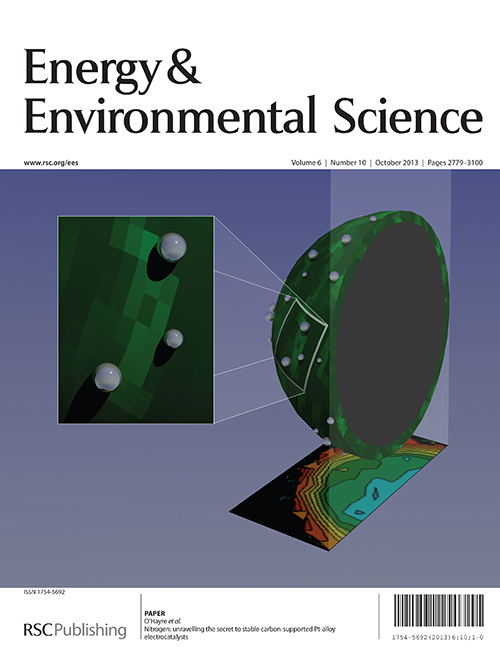GOLDEN, Colo., Nov. 5, 2013 – The results of a collaboration between scientists at the Colorado School of Mines and the Energy Department’s (DOE) National Renewable Energy Laboratory (NREL) are featured on the cover of the October 2013 edition of the journal Energy and Environmental Science.
 The article, “Nitrogen: unraveling the secret to stable carbon-supported Pt-alloy electrocatalysts,” explains why fuel cell performance can be significantly boosted by doping nitrogen into the carbon-supported electrocatalysts that are typically used in these devices.
The article, “Nitrogen: unraveling the secret to stable carbon-supported Pt-alloy electrocatalysts,” explains why fuel cell performance can be significantly boosted by doping nitrogen into the carbon-supported electrocatalysts that are typically used in these devices.
The Mines team received funding from the U.S. Army Research Office and the NREL team was funded by the Fuel Cell Technologies Office in DOE’s Office of Energy Efficiency and Renewable Energy. Scientists from DOE’s Oak Ridge National Laboratory (through the ShaRE program) and Stanford University also participated in this research project.
“Fuel cells require expensive platinum/carbon catalysts,” explained Ryan O’Hayre, Mines’ principal investigator for the project. “The idea that you can significantly boost their performance by adding abundant, inexpensive nitrogen is therefore significant.”
“Although it is widely known that nitrogen doping increases performance, we didn’t clearly understand why,” said Huyen Dinh, NREL’s principal investigator for the project.
Through analysis of electron energy-loss spectral imaging datasets acquired via a scanning transmission electron microscope, the team observed a nanoscale spatial relationship between surface nitrogen and metal catalyst nanoparticles on a carbon support.
“Our study correlated improved catalyst-support interactions with high substrate nitrogen content in the immediate proximity of stabilized nanoparticles,” Dinh added. “We applied these insights to direct methanol fuel cells, using both NREL-prepared and commercial catalysts doped with nitrogen, and demonstrated substantial improvements in performance—40 percent initially—as well as long-term stability. After 645 hours of durability testing, the performance of the fuel cells with the nitrogen-doped catalysts was six times higher than the performance of the fuel cells with the un-doped catalysts. ”
According to the research team, these results could have a major impact on the design and optimization of next-generation high-performance catalyst materials.
“The success of this research project was made possible thanks to the long-standing and highly integrated collaboration between NREL and Mines team members,” Dinh said. “Special thanks go to Mines professor Svitlana Pylypenko; Dr. Thomas Gennett and Dr. Arrelaine Dameron of NREL; and to Mines graduate students April Corpuz and Kevin Wood, who leveraged expertise and facilities at both institutions to push this work forward,” said Dinh.
Contact:
Karen Gilbert, Director of Public Relations, Colorado School of Mines / 303-273-3541 / kgilbert@mines.edu
Kathleen Morton, Communications Coordinator, Colorado School of Mines / 303-273-3088 / kmorton@mines.edu
